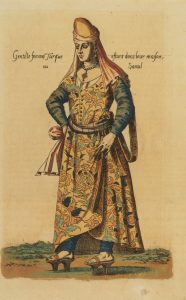Written by Gavin Moulton (Class of 2020)

Aga of the Janissaries. Colored engraving by Jacques Charles Bar, 1789. The Edwin Binney 3rd Collection of Orientalist Prints, Fine Arts Library.
As a student assistant in the Fine Arts Library, I spent the Spring semester diving into the prints of the library’s recently acquired Edwin Binney 3rd Collection of Orientalist Prints. This collection is an unparalleled resource for the study of Western and Central European perceptions of the Ottoman Empire. It also offers an interesting look into the mind of American collector Edward Binney 3rd (Harvard PhD 1961). It appears that Binney had booksellers and antiquarians on the lookout for any material illustrating Turkish or Ottoman-related subjects.
That has left the collection with a mélange of drawings, engravings, lithographs, aquatints, and even illustrated sheet music, dating from the 15th century to the early 20th century, the work of artists active in Europe and the Middle East. The late Edwin Binney 3rd is better known for his collections of Ottoman and Mughal miniatures, now held by the Harvard Art Museums, the Los Angeles County Museum of Art, and the San Diego Museum of Art. But the substantial and surprising variety of European prints and ephemera makes this lesser-known collection, donated by his family to the Fine Arts Library, a wonderfully relevant source that traces the visual development of Orientalism.
Compared to painting or literature, prints have been relatively understudied in relation to Orientalist discourse, yet their wide circulation certainly had a profound impact on everyday perceptions of the Ottoman world. The longue durée covered by the Binney collection also provides unique insight into the (often nefarious) practice of repurposing and relabeling prints decades or even centuries after their original creation. Not only does this make it difficult for student catalogers like me to correctly identify works, it has also been a challenge for scholars in the past. Many publications incorrectly identify figures in some recycled prints by the listed caption, without noting the original creator and subject of the image. Thus, these images need to be approached critically, as any label may be intentionally misleading.
Particular strengths of this collection include lithographed 19th c. sheet music, a variety of costume albums and prints, and travelogues illustrated by artists such as Nicolas de Nicolay (1517-1583), Melchior Lorck (1527-ca. 1590), and Claude DuBosc (1682–1745?). While the collection will be of most interest to those studying the development of Orientalist art, there is rich material for Ottomanists, scholars of French and German prints, and literary historians. The great variety of the material in the collection brings new awareness of how Ottoman identity was perceived, visually constructed and projected in cities such as Paris, Berlin, Venice, London, and Madrid.

View over the rooftops of Constantinople. Pen and ink drawing by Melchior Lorck, between 1555 and 1559. Statens museum for kunst, Copenhagen.
Aside from historical insight, many of the prints are of high artistic value, especially those by the famed Danish artist Melchior Lorck. The talented and inventive printer Melchior Lorck was no fan of the Ottoman Empire, where he was sent as part of an embassy from the Holy Roman Emperor. The time Lorck spent in Constantinople (1555-1559) seems to have been mostly miserable, spent in intermittent detention by the Ottoman government, which must have contributed to his poor view of the state. Though at first glance, his prints may not seem overtly negative, they contain subversive imagery that paints the empire in a negative light. Take for example, his print of Constantinople’s rooftops. It appears to be an almost photographic impression of a view (maybe from the room where he was staying), with terracotta rooftiles and the lead covered dome of a nearby Islamic building. Closer inspection, however, shows a couple making love in a terraced overhang. Another print in this fashion is one showing the Süleymaniye Mosque complex. While ostensibly focused on the architecture, it features apocalyptic imagery, with the moon (representing Islam) being eclipsed by a mass of clouds, as the bright shining sun (of Christianity) bursts forth. The most comprehensive book on Lorck’s work, by Erik Fischer, often glosses over the political undertones of his prints that viewers will discover at first hand in the Binney collection.

The Süleymaniye Mosque, Constantinople. Print by Melchior Lorck, 1570. The Edwin Binney 3rd Collection of Orientalist Prints, Fine Arts Library.
It is fortunate that this resource is located in an art library, as that facilitates easy comparison with readily available reference tools and secondary materials. This is key, due to the complexity of the collection and the pitfalls of studying prints. The future digitization of this collection will make it a useful tool for all scholars and students of Ottoman history.
